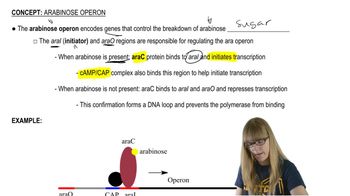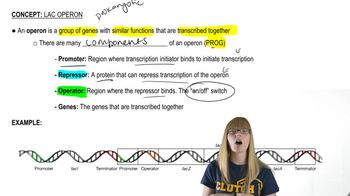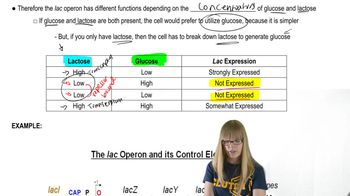Table of contents
- 1. Introduction to Genetics51m
- 2. Mendel's Laws of Inheritance3h 37m
- 3. Extensions to Mendelian Inheritance2h 41m
- 4. Genetic Mapping and Linkage2h 28m
- 5. Genetics of Bacteria and Viruses1h 21m
- 6. Chromosomal Variation1h 48m
- 7. DNA and Chromosome Structure56m
- 8. DNA Replication1h 10m
- 9. Mitosis and Meiosis1h 34m
- 10. Transcription1h 0m
- 11. Translation58m
- 12. Gene Regulation in Prokaryotes1h 19m
- 13. Gene Regulation in Eukaryotes44m
- 14. Genetic Control of Development44m
- 15. Genomes and Genomics1h 50m
- 16. Transposable Elements47m
- 17. Mutation, Repair, and Recombination1h 6m
- 18. Molecular Genetic Tools19m
- 19. Cancer Genetics29m
- 20. Quantitative Genetics1h 26m
- 21. Population Genetics50m
- 22. Evolutionary Genetics29m
12. Gene Regulation in Prokaryotes
Lac Operon
Problem 2e
Textbook Question
Transcriptional regulation of operon gene expression involves the interaction of molecules with one another and of regulatory molecules with segments of DNA. In this context, define and give an example of each of the following: inducer
 Verified step by step guidance
Verified step by step guidance1
Understand that an inducer is a molecule that initiates or enhances the expression of a gene by interacting with a repressor protein or directly with the DNA.
Recognize that in the context of an operon, an inducer can bind to a repressor protein, causing a conformational change that reduces the repressor's affinity for the operator region of the DNA.
Consider the classic example of the lac operon in E. coli, where lactose or its isomer allolactose acts as an inducer.
In the lac operon, the inducer binds to the lac repressor, causing it to release from the operator, allowing RNA polymerase to transcribe the downstream genes necessary for lactose metabolism.
Reflect on how the presence of an inducer can lead to the expression of genes that are otherwise repressed, demonstrating a key mechanism of gene regulation in prokaryotes.
Recommended similar problem, with video answer:
 Verified Solution
Verified SolutionThis video solution was recommended by our tutors as helpful for the problem above
Video duration:
3mPlay a video:
Was this helpful?
Key Concepts
Here are the essential concepts you must grasp in order to answer the question correctly.
Inducer
An inducer is a molecule that initiates gene expression by binding to a repressor protein, causing it to release from the operator region of an operon. This interaction allows RNA polymerase to access the promoter and transcribe the downstream genes. A classic example is lactose, which acts as an inducer for the lac operon in E. coli, enabling the bacteria to metabolize lactose when it is present.
Recommended video:
Guided course

Induced Mutations
Operon
An operon is a cluster of genes under the control of a single promoter and regulated together, allowing for coordinated expression in response to environmental changes. Operons typically consist of structural genes, a promoter, and an operator. The lac operon is a well-studied example, consisting of genes necessary for lactose metabolism, regulated by the presence or absence of lactose.
Recommended video:
Guided course

Arabinose Operon
Transcriptional Regulation
Transcriptional regulation refers to the mechanisms that control the rate of gene transcription, determining how much of a gene's product is produced. This regulation can involve various factors, including transcription factors, enhancers, silencers, and inducers. It is crucial for cellular responses to environmental signals and is fundamental in processes like development and differentiation.
Recommended video:
Guided course

Eukaryotic Transcription

 4:27m
4:27mWatch next
Master Lac Operon Overview with a bite sized video explanation from Kylia Goodner
Start learning



